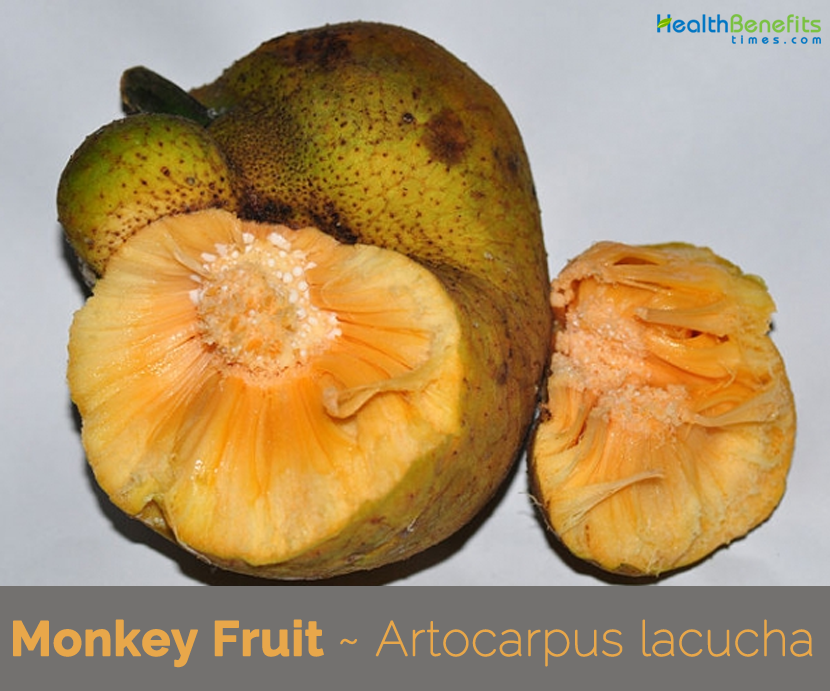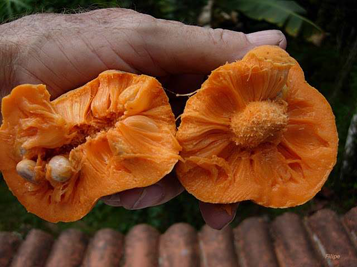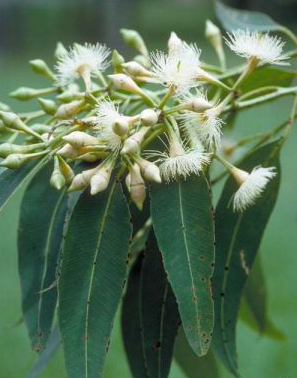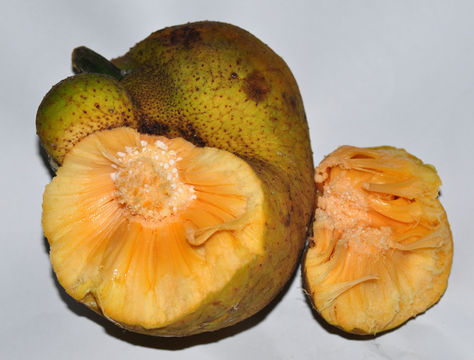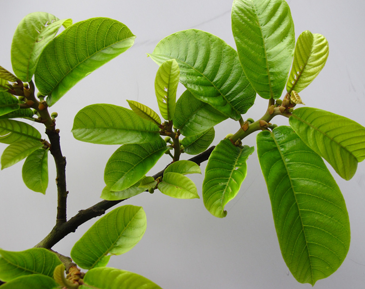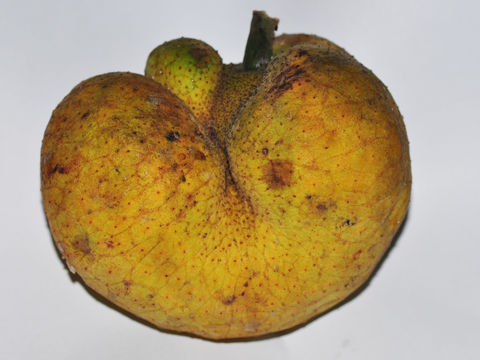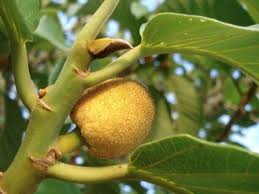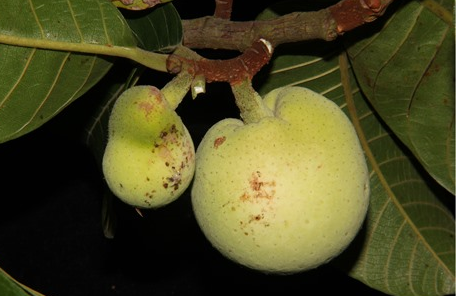| Monkey Fruit Quick Facts |
| Name: |
Monkey Fruit |
| Scientific Name: |
Artocarpus lacucha |
| Origin |
Indian subcontinent and SE Asia |
| Colors |
Green to a dull yellow, and finally settles on a pinkish brownish yellow tinge when fully ripe |
| Shapes |
Syncarp, nearly round or irregular, 2 to 5 inches wide |
| Flesh colors |
Vibrant orange-pink color |
| Taste |
Sweet, sour, tangy taste with citrusy overtones |
| Health benefits |
Helps in prevention of diseases like cancer, diabetes, neuro degenerative ailments and coronary heart diseases |
Artocarpus lacucha, also known as monkey fruit, or Monkey Jack fruit is a tropical evergreen tree species of the Moraceae family. The plant is distributed throughout the Indian Subcontinent and Southeast Asia and is available in some Asian countries like Bangladesh, Bhutan, Nepal, Myanmar, Sri Lanka, Thailand, Malaysia, Singapore, Vietnam, Cambodia and Laos. The tree is valued for its wood; its fruit is edible and is believed to have medicinal value. Some of the popular common names of the plants are Monkey jack, Monkey jack tree, Monkey fruit and Monkey jack fruit. The generic name comes from the Greek words ‘artos’ which means bread and ‘karpos’ means fruit while the species name is derived from the fruit’s common name in India. Fruits are highly nutritious and are an important food item in the human diet. This fruits consists of vitamins and most of the vitamins excellent source of antioxidant which are vitamin C and beta-carotene.
Plant description
The plant is medium to large deciduous tree that grows about 10-15 m tall. The plant is found growing in lowland hill forests, open country, and sometimes villages, up to 300 m altitude. It occurs locally along Mandai Road, in Nee Soon Swamp Forest, and Pulau Ubin. It prefers a deep, well-drained soil and grows well in deep permeable soils with a good supply of moisture. The bark is grey and the slash is deep red with milky latex. Branchlets are 3-6 mm thick, densely covered with stiff pale brown to yellow velvety hairs. This tree is mentioned in the Arthashastra.
Leaves
Leaves are large, alternate 25-30 cm long, 15-20 cm wide, sometimes pinnately lobed, base wedge-shaped, and tip blunt. Leaf margin is entire or with small teeth.
Flower & Fruit
Flowers are unisexual, male and female flowers in separate spherical heads but on the same tree. Male flowers are yellow-orange while the female are reddish. Flowers are followed by syncarp (the entire female inflorescence forms a fruit). They are nearly round or irregular, 2 to 5 inches wide. Fruits are green to a dull yellow, and finally settle on a pinkish brownish yellow tinge when fully ripe with sweet sour pulp which is occasionally eaten raw but mostly made into curries or chutney. The size differs but the diameter is typically 5-10 cm while fruit weights 200-350 g. The number of seeds/fruit varies accordingly, but typically there are 10-30 per fruit. Seeds are irregular and vary in size like the fruits. At maturity, most seeds are about one cm long, more or less flattened and pointed at the embryo end; the seed-coat is thin and white. Seeds contain sticky white latex.
The male flower spike is pickled. The fruit’s texture is like a jackfruit’s with its stringy, fibrous, mildly rubbery consistency. The lakucha fruit is highly nutritious with antioxidant properties of beta-carotene and vitamin C. This particular antioxidant helps in the maintenance of the normal human health, prevents heart diseases that are coronary in nature, and provides a tough fight against cancer as well.
Monkey Fruit Prevents a Host of Diseases
This fruit has ultimately grabbed the attention of various scientists and Ayurvedic physicians who are looking out for various ways in which this magical fruit can be used. According to study, it has been seen that the proper consumption of the Monkey fruit results in the prevention of diseases like cancer, diabetes, neurodegenerative ailments and coronary heart diseases. It also possesses anti-inflammation, antibacterial, antioxidant and cytotoxic properties which are vehemently used as potential therapeutic attributes. It is an important ingredient in many Ayurvedic medicines.
The lakucha or the monkey jack fruit has a unique flavor which is not easily found in any other fruit. The taste is a mixture of sweet, tangy and sour. It is used to cure skin problems as well as it is a huge source of minerals, vitamins, polyphenols, and fibers, which provide a number of health benefits when consumed in the proper quantity.
Benefits of Consuming Monkey Fruit
The vivid consumption of the lakucha fruit acts refreshment for the liver and the seeds and latex of the fruit are used as a purgative. Bark and seed of the lakucha plant are also used for various liver and stomach diseases. It is used in the context of anti-inflammatory therapy and works really well as an anti-aging skin agent with an additional skin whitening effect.
The lakucha fruit also manages to decrease the problems of hair loss and helps in the regrowth of hair from the hair follicles and also make hair shafts stronger. It is a blessing in the treatment of skin diseases where it effectively eradicates the darkening of the skin and brings a natural glow to the skin. Lakucha also obviously treats dysentery, arthritic swelling and cleans wounds.
Having so many medicinal properties, lakucha or the monkey jack fruit proves to a fruit with high end nutritional as well as medicinal use. It should be consumed in proper quantities aiming to result in some successful treatment of diseases.
Traditional uses and benefits of consuming Monkey fruit
- Extract of the fruit reduces hair loss and stimulates the propagation of hair, skin diseases, herpes can make it fade away the darkening of the skin.
- It may also treat arthritic swelling, dysentery and clean wounds.
- Fruit pulp act as refresher of liver as well as seeds and milky latex can used as purgative.
- Tree bark consists of 8.5 percent tannin and is used to treat skin lesion.
- Powder formed bark is applied to cure any wound and also used to draw out purulent matter from any abscess.
- Seed and bark of the plant are useful for stomach and liver disease.
- Ripe fruit is sour sweet, tonic to liver.
- Seed are good purgative for children.
- Juice and seeds from this plant are used as purgative and the bark is used as astringent.
- Root is used as refresher and the leave are used in treating dropsy.
- Powered form heartwood extract has been using as an effective and economical skin-whitening agent.
- lakoocha plant is used in traditional Thai medicine for anti-inflammatory therapy and as well as an anti-skin aging agent.
- lakoocha extract was effective for the treatment of taeniasis.
- lakoocha is widely used as medicinal plant for the treatment of some specific diseases in India.
- Dried aqueous extract of A. lakoocha has been used for treatment of tape worms.
- Root of A. lakoocha is an astringent and is used as a purgative.
- Saturated extract is used as a poultice for skin ailments and bark is used to treat headache.
- Fruit can be used as food supplement to combat malnutrition and reduces the risk of several diseases.
- Sap and juice of the bark is applied externally to boils, pimples, cuts and wounds.
- Macerated bark is used as a poultice for treating skin ailments. The bark is used to treat headache.
Culinary uses
- Fruits are generally sweet sour pulp eaten fresh but mostly made into curries.
- Unripe fruit and male flower spike of A. lakoocha are used to prepare curries, pickles and sauce.
- Different parts of this tree like fruits and male flowers are eaten raw, boiled, steamed or roasted.
- Broad, flat seeds are edible.
- Bark contains tannin and is chewed as a substitute for betel nut.
Different uses of Monkey Fruit
- Food: The fruits and male flowers are eaten raw, boiled, steamed or roasted.
- Fodder: In Nepal it is highly valued as a fodder tree in the lower foothills of the Himalayas. The leaves contain about 16% crude protein and one tree produces between 60 and 200 kg fresh fodder in a year. It is fed to lactating animals and considered one of the most important milk producing forages.
- Fuel: Trees are an important source of firewood.
- Timber: Wood is hard and termite resistant with a weight of about 640 kg/m3. It is used in heavy construction, poles, beams, furniture boats, wood based materials and plywood.
- Latex or rubber: Sticky latex is present in all parts of the tree and has many uses.
- Tannin or dyestuff: Tree bark (containing 8-9% tannin) is chewed like betel nut. The wood and roots yield a lavish color dye.
- Lipids: The fat extracted from the seed is a light yellow liquid, viscous at room temperature.
- Medicine: Root is an astringent and is used as a purgative; when macerated it was used as a poultice for skin ailments. The bark is used to treat headache.
- Shade or shelter: A perennial tree crop that provides beneficial shade and cooler microclimate for humans, plants and animals beneath its canopy.
- Soil improver: The tree can be used to provide mulch.
- Ornamental: Occasionally grown as an ornamental plant.
- Intercropping: It is an important component of traditional agroforestry systems. The trees are integrated into mixed cropping systems with other crop
Other Facts
- Tree is also used as food and timber.
- Timber and wood from this tree used to made furniture, boats and cabinets.
- It also used for heavy construction, poles, furniture and plywood for its hard and termite resistant capacities.
- One mature tree produces 60-200 kg fresh feedstuff in a year.
- Tree can be used for protection and occasionally it grown as an ornamental bonsai plant.
- Skin of the fruit when cut exudes white latex with similar texture of a jackfruit.
- Fiber obtained from the inner bark is used for cordage.
- Yellow coloring matter is obtained from the wood and roots. It is used for dyeing textiles.
- Wood is an important local source of fuel.
References:
https://davesgarden.com/guides/pf/go/154422/
https://npgsweb.ars-grin.gov/gringlobal/taxonomydetail.aspx?id=409385
http://www.bgci.org/plant_details.php?plantID=70364
http://www.theplantlist.org/tpl1.1/record/kew-2654005
https://en.wikipedia.org/wiki/Artocarpus_lacucha
http://www.wikiwand.com/en/Artocarpus_lacucha
https://ipfs.io/ipfs/QmXoypizjW3WknFiJnKLwHCnL72vedxjQkDDP1mXWo6uco/wiki/Artocarpus_lacucha.html
Comments
comments


